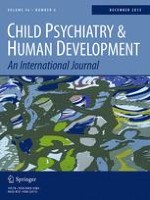14-02-2015 | Original Article
Effects of Callous–Unemotional Traits on the Association Between Parenting and Child Conduct Problems
Gepubliceerd in: Child Psychiatry & Human Development | Uitgave 6/2015
Log in om toegang te krijgenAbstract
The current study investigated whether and how callous–unemotional traits (CU) moderated the association between specific parenting practices and child conduct problems (CP) with a special consideration of informant patterns. Associations between CU, ODD and CD symptom severity, and the parenting practices of deficient monitoring, positive involvement, and negative/ineffective discipline were examined across parent and teacher reports on 851 elementary-school students. Relative to children with low CU, in children with high CU: (1) positive parenting was associated with lower CD, but increased ODD; (2) negative/ineffective discipline was associated with increased ODD; (3) deficient monitoring was associated with increased CD. Results were not robust across informants. These findings suggest that in the context of CU, the associations between parenting and CP differ based on parenting characteristics, CP dimensions, and informant, and that families may benefit from treatment targeting specific parenting practices based on CP symptom profiles.
